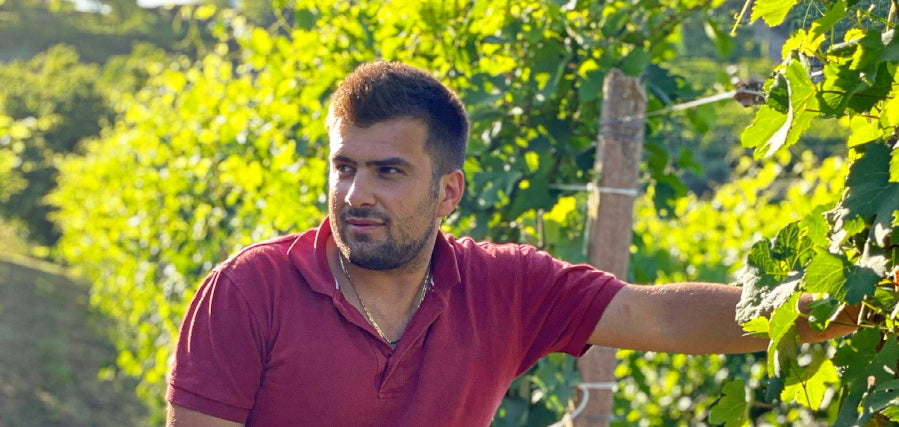Your Cart is Empty
UK MAINLAND FREE DELIVERY & 10% OFF £150+ ORDERS
UK MAINLAND FREE DELIVERY & 10% OFF £150+ ORDERS
There is a new Nebbiolo warrior in the Langhe. His name is Stefano Porro. Born in 1993, Stefano took over his family winery in 2019 with a clear goal: to make outstanding terroir-driven wine from his tiny cantina in Serralunga.
The story of the winery goes back to 1966 when Stefano’s grandfather Carlo inherited one hectare of land in “localita’ Cerrati” near Serralunga. From his farm known locally as “Cascina del Toro” (the bull’s farm) – Carlo was allegedly the only farmer with a bull in the area at the time, Carlo raised livestock and farmed a mixture of fruit, grain and grapes to sell in bulk. Carlo also bottled some Barolo and Dolcetto to share with his family and friends.
In 2019, after gaining solid experience working at another local winery, Stefano took over the family vineyard holdings and cantina from his dad determined to make his own mark.
In his first vintage, Stefano released 1,600 bottles of Nebbiolo and 1,000 bottles of Barbera d’Alba Superiore, which were both immediately almost entirely sold out to local restaurants, friends and family and to a few “well-informed” Piedmont cognoscenti who had the opportunity to snap a case directly from the winery. In 2023, Stefano is planning to release a new Dolcetto and his highly anticipated inaugural 2019 Barolo (entirely allocated on advance pre-order).
Stefano’s vineyards in Serralunga are on average 25/30yo and located right on the Brea MGA border, which today is entirely under the Brovia monopole. Stefano, however, believes that the Brea designation could soon be extended to include his land, which benefits from an almost identical soil composition and terroir to his famous neighbours. The soil here on the east slope of Serralunga, is composed of mostly clay with veins of limestone that give bold and complex wines with great finesse and excellent drinkability.
“Barolo was born in this part of Serralunga as this is the only slope in this sub-zone which gives wines with the perfect balance of colour, perfume and taste.”
Carlo Porro
Stefano follows sustainable viticulture and is ethos is to let the wine express its terroir in full. The work in the vineyards is manual and treatments are carried out only when necessary. Stefano uses “Sangue di Bue” (oxblood), an organic manure, to fertilise his soil. Grapes are selected strictly by hand by Stefano during harvest. Yield is approx. 12/13 bunches per vine, but after green harvest and manual selection only 8/9 bunches are used to make Stefano’s wines. This is an important step in the process since fermentation takes place naturally without the addition of any yeast, which requires the grapes to be in perfect condition when the vinification begins. In the cellar all racking processes are carried out strictly by hand to protect the grapes from shocks and unwanted bacteria.
The Nebbiolo is fermented 50% whole cluster and 50% whole bunch. Fermentation takes place in cement vats (with Pied de Cuve carried out 5 days before the beginning of the fermentation process). No yeast is added during the process which lasts between 10 and 20 days depending on the vintage. After fermentation the wine is soft pressed, the solids are separated and removed from the juice and then second fermentation (malolactic) takes place in stainless steel vats. After the malolactic fermentation, the wine begins the ageing process in “legno”. The Nebbiolo 2020 was aged in barriques, 2021 and 2022 were aged in tonneaux. Stefano’s plan is to increase his production year on year and move to larger botti as soon as the quantity produced is large enough to fill an entire barrel! The Nebbiolo ages in wood for a total of seven to eight months, depending on the vintage and once bottled it rests in the cellar for a further 30 - 45 days.
For the Barbera, Stefano currently uses grapes sourced from his uncle’s 50 y/o vineyards in Bricco San Pietro (Monforte). Fermentation is similar to the fermentation of the Nebbiolo, except that the Barbera is entirely made with whole clusters. During the fermentation process, the stems are removed and the “Mosto Fiore” (free-run wine) is separated from the solids. No pressing takes place and the wine ages in 350l tonneaux for 7 months before being bottled. According to Stefano, this vinification process is aimed at producing a Barbera which is fresh, elegant and approachable like the Barbera produced in the Asti zone, which in Stefano’s opinion is the best Barbera region in the world.
The Barolo goes through a traditional vinification process and ages for 18 months in used “Gamba” barriques, which were gifted to Stefano by Marco Allario from Cantina Piazza as a lucky charm when Stefano decided to embark on his ambitious project.
Stefano is fast developing a reputation as a producer to watch in Barolo. Total production is currently around 3,000 btls and at Ultravino we are very excited to playing a role in bringing this exceptional Serralunga micro-winery to the attention of discerning Piedmont fine wine lovers.
Ultravino is the UK exclusive importer
Wines:
Barbera d’Alba Superiore
Langhe Nebbiolo
Barolo
